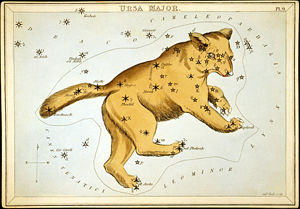
Alcor B
Encyclopedia

Red dwarf
According to the Hertzsprung-Russell diagram, a red dwarf star is a small and relatively cool star, of the main sequence, either late K or M spectral type....
stellar companion to the bright star Alcor in the Ursa Major
Ursa Major
Ursa Major , also known as the Great Bear, is a constellation visible throughout the year in most of the northern hemisphere. It can best be seen in April...
constellation. The two are components of the Mizar-Alcor stellar sextuple system
Mizar (star)
The Mizar–Alcor stellar sextuple system consists of the quadruple system Mizar and the binary system Alcor.- Description :Mizar is a quadruple system of two binary stars in the constellation Ursa Major and is the second star from the end of the Big Dipper's handle. Its apparent magnitude is 2.23...
.
Alcor B was discovered independently by two groups in 2009—a group led by Eric Mamajek (University of Rochester
University of Rochester
The University of Rochester is a private, nonsectarian, research university in Rochester, New York, United States. The university grants undergraduate and graduate degrees, including doctoral and professional degrees. The university has six schools and various interdisciplinary programs.The...
) and colleagues at Steward Observatory
Steward Observatory
The University of Arizona's Steward Observatorys main office is located on the University's campus and is closely tied to the Department of Astronomy. Established in 1916 by its first director, Andrew Ellicott Douglass, and a $60,000 bequest made by Lavinia Steward in memory of her late husband...
University of Arizona
University of Arizona
The University of Arizona is a land-grant and space-grant public institution of higher education and research located in Tucson, Arizona, United States. The University of Arizona was the first university in the state of Arizona, founded in 1885...
that used the 6.5-meter telescope at MMT Observatory
MMT Observatory
The MMT Observatory is an astronomical observatory on the site of Fred Lawrence Whipple Observatory . The Whipple observatory complex is located on Mount Hopkins, Arizona, USA in the Santa Rita Mountains...
, and another led by Neil Zimmerman, a graduate student at Columbia University
Columbia University
Columbia University in the City of New York is a private, Ivy League university in Manhattan, New York City. Columbia is the oldest institution of higher learning in the state of New York, the fifth oldest in the United States, and one of the country's nine Colonial Colleges founded before the...
and member of
Project 1640, an international collaborative team that includes astrophysicists at the American Museum of Natural History
American Museum of Natural History
The American Museum of Natural History , located on the Upper West Side of Manhattan in New York City, United States, is one of the largest and most celebrated museums in the world...
, the University of Cambridge
University of Cambridge
The University of Cambridge is a public research university located in Cambridge, United Kingdom. It is the second-oldest university in both the United Kingdom and the English-speaking world , and the seventh-oldest globally...
's Institute of Astronomy, the California Institute of Technology
California Institute of Technology
The California Institute of Technology is a private research university located in Pasadena, California, United States. Caltech has six academic divisions with strong emphases on science and engineering...
, and NASA
NASA
The National Aeronautics and Space Administration is the agency of the United States government that is responsible for the nation's civilian space program and for aeronautics and aerospace research...
's Jet Propulsion Laboratory
Jet Propulsion Laboratory
Jet Propulsion Laboratory is a federally funded research and development center and NASA field center located in the San Gabriel Valley area of Los Angeles County, California, United States. The facility is headquartered in the city of Pasadena on the border of La Cañada Flintridge and Pasadena...
, that used the 5-meter Hale telescope
Hale telescope
The Hale Telescope is a , 3.3 reflecting telescope at the Palomar Observatory in California, named after astronomer George Ellery Hale. With funding from the Rockefeller Foundation, he orchestrated the planning, design, and construction of the observatory, but did not live to see its commissioning...
at Palomar Observatory
Palomar Observatory
Palomar Observatory is a privately owned observatory located in San Diego County, California, southeast of Pasadena's Mount Wilson Observatory, in the Palomar Mountain Range. At approximately elevation, it is owned and operated by the California Institute of Technology...
.
The companion star was unofficially nicknamed "Eleonora" by the former group.
Alcor A and B are situated 1.2 light years
Light Years
Light Years is the seventh studio album by Australian recording artist Kylie Minogue. It was released on 25 September 2000 by Parlophone and Mushroom Records. The album's style was indicative of her return to "mainstream pop dance tunes"....
away from, and are co-moving with, the Mizar quadruple system, making the system the second known stellar sextuplet—only Castor (star)
Castor (star)
Castor is the second brightest star in the constellation Gemini and one of the brightest stars in the night sky. Although it has the Bayer designation "alpha", it is actually fainter than Beta Geminorum...
is closer. The Mizar-Alcor stellar sextuple system belongs to the Ursa Major Moving Group
Ursa Major Moving Group
The Ursa Major Moving Group, also known as Collinder 285 or Ursa Major association, is a nearby stellar moving group, a set of stars with common velocities in space and thought to have a common origin. Its core is located roughly 80 light years away...
, a nearby stellar group of stars of similar ages and velocities.

